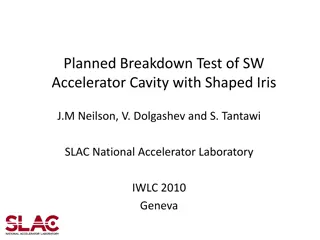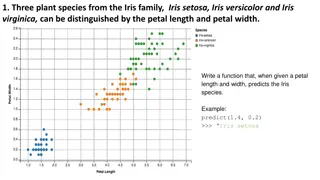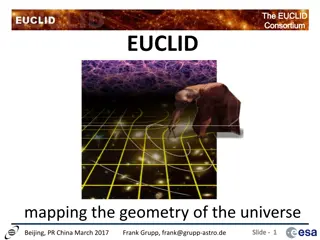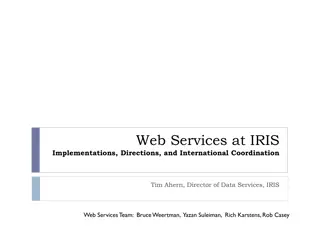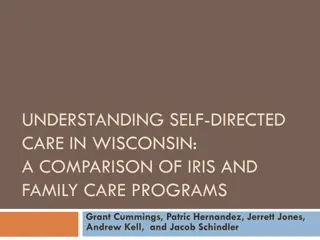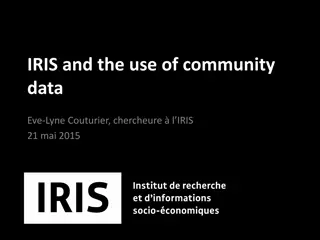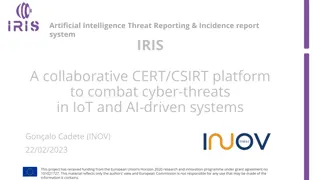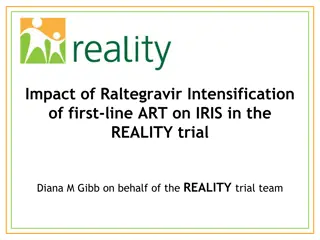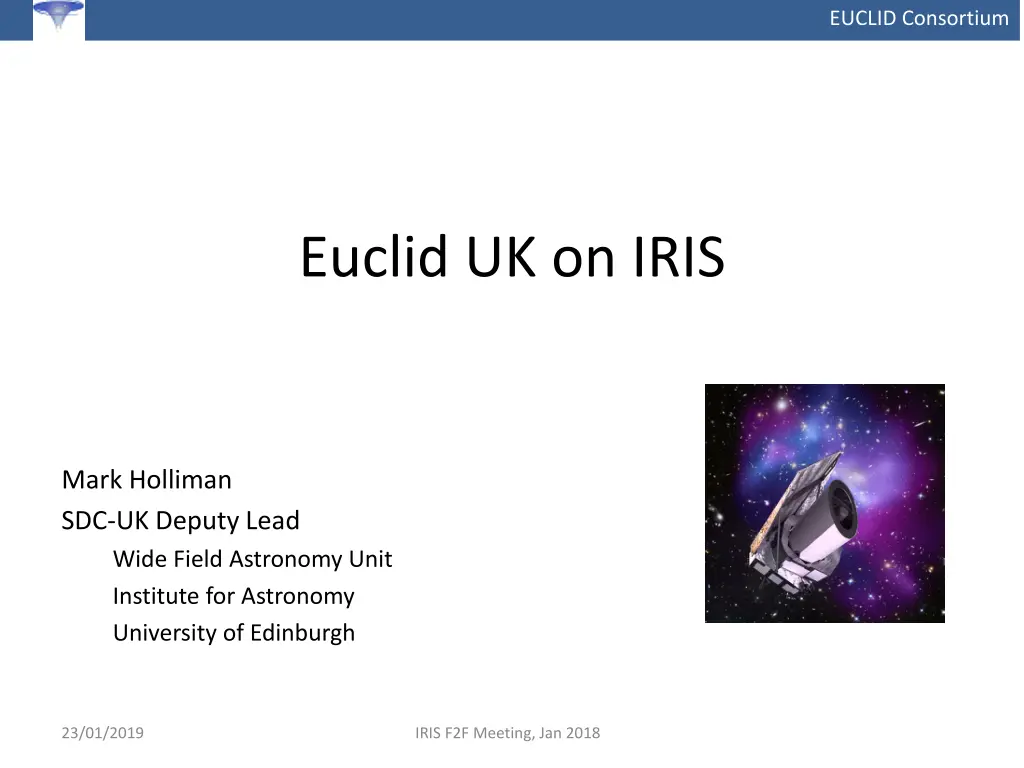
EUCLID Consortium Mission Overview
"Discover the EUCLID Consortium's mission in the Cosmic Visions Programme, including objectives, operational details, and collaborative efforts with IRIS on data processing. Learn about the significant scientific goals and technological advancements achieved by this international consortium. Explore the integration of Saas infrastructure for simulations and data processing, paving the way for groundbreaking research in astronomy."
Download Presentation

Please find below an Image/Link to download the presentation.
The content on the website is provided AS IS for your information and personal use only. It may not be sold, licensed, or shared on other websites without obtaining consent from the author. If you encounter any issues during the download, it is possible that the publisher has removed the file from their server.
You are allowed to download the files provided on this website for personal or commercial use, subject to the condition that they are used lawfully. All files are the property of their respective owners.
The content on the website is provided AS IS for your information and personal use only. It may not be sold, licensed, or shared on other websites without obtaining consent from the author.
E N D
Presentation Transcript
EUCLID Consortium Euclid UK on IRIS Mark Holliman SDC-UK Deputy Lead Wide Field Astronomy Unit Institute for Astronomy University of Edinburgh 23/01/2019 IRIS F2F Meeting, Jan 2018
EUCLID Consortium Euclid Summary ESA Medium-Class Mission In the Cosmic Visions Programme M2 slot (M1 Solar Orbiter, M3 PLATO) Due for launch December 2021 Largest astronomical consortium in history: 15 countries, ~2000 scientists, ~200 institutes. Mission data processing and hosting will be spread across 9 Science Data Centres in Europe and US (each with different levels of commitment). Scientific Objectives To understand the origins of the Universe s accelerated expansion Using at least 2 independent complementary probes (5 probes total) Geometry of the universe: Weak Lensing (WL) Galaxy Clustering (GC) Cosmic history of structure formation: WL, Redshift Space Distortion (RSD), Clusters of Galaxies (CL) Euclid on IRIS in 2018: First use of Slurm as a service (Saas) deployment on IRIS resources at Cambridge on the not-quite-decommissioned Darwin cluster with support from Cambridge HPC and Stack HPC teams Used for Weak Lensing pipeline sensitivity test simulations ~15k cores for 8 weeks from August-October Generated ~200TB of simulations data on the Lustre shared filesystem during that time (along with ~2TB of data on a smaller Ceph system) User logins through SSH, jobs run through Slurm DRM head node, workload managed by the Euclid IAL software and pipeline executables distributed through CVMFS (as per mission requirements). Successful example of Saas, and now we d like to see the Saas tested/operated on a federated basis 15/03/2018 TK0 Collaboration Meeting, Mar 2018
EUCLID Consortium Euclid UK on IRIS in 2019 Three main areas of work: Shear Lensing Simulations: Large scale galaxy image generation and analysis simulations (similar to the simulations run on IRIS at Cambridge in 2018, though larger in scope). These simulations require worker nodes/containers running CentOS7, CVMFS, with 2GB RAM per core, and a shared filesystem visible to the head node and workers. The Euclid job submission service (called the IAL) needs to be running on/near the head node for overall workflow management. (requested ~3k core years from IRIS for 2019) Mission Data Process Scale out: Proof of concept using IRIS Slurm as a Service (Saas) infrastructure to scale out workloads from the dedicated cluster in Edinburgh to resources at other IRIS providers. The goal is to have a working Saas solution tied into our existing infrastructure ready by 2020 for the final phase of Euclid end-to-end tests. The base requirements for this are the same as those for the Shear Lensing simulations discussed above (though with a higher RAM requirement of 8GB per core), as the Shear pipeline code is merely a subset of the full Euclid pipeline which will run during operations. Science Working Group Simulations (led by Tom Kitching): Science Performance Verification (SPV) simulations for setting the science requirements of the mission, and used to assess the impact of uncertainty in the system caused by any particular pipeline function or instrument calibration algorithm. The SPV simulations run in Python2 (with additional scientific libraries), and require 6GB RAM per core and a shared filesystem for data workflow management. For administrative and accounting purposes it is likely that these will run on the same Saas infra used for other Euclid activities to minimize effort duplication. (requested ~1.5k core years from IRIS for 2019) 15/03/2018 TK0 Collaboration Meeting, Mar 2018
EUCLID Consortium Euclid UK on IRIS 2020 Shear pipeline sensitivity testing The UK developed pipeline algorithms need to be tested at scale pre-launch (Dec 2021) to ensure accuracy and performance, and then yearly simulations will need to be run post-launch for generating and refining calibration data. Pre-launch simulations are estimated to require ~3k core years per year, and 200TB of intermediate (shared) file storage. Post-launch simulation are estimated to require ~1.5k core years per year, and 100TB of intermediate (shared) file storage. Mission Data Processing Euclid UK will have a dedicated cluster for day-to-day data processing over the course of the mission, but it is expected that this will be insufficient at peak periods (i.e. official data releases, data reprocessing). During these periods we need to scale out onto other resource providers, ideally through an Saas system (or something equivalent). It is also possible/likely that we would want to use a shared tape storage system for archiving older Euclid data. Estimates currently anticipate ~1.5k core years and 100TB of intermediate (shared) file storage from 2022- 2024. Data tape estimates are currently very fuzzy while we await the mission SLA s to be finalized, but they should be on the order of growing 100TB a year per year from 2020 onwards Science Working Group The weak lensing SWG anticipates a similar need for simulations in 2020 as in 2019 (1.5k core years). But then the SWG expects to ramp up significantly on launch year and beyond, running a suite of simulations for verifying mission science requirements and data analysis 2021 - 4k core years, 100TB of intermediate (shared) file storage 2022 5k core years 200TB of intermediate (shared) file storage 2023 5k core years 200TB of intermediate (shared) file storage 15/03/2018 TK0 Collaboration Meeting, Mar 2018








